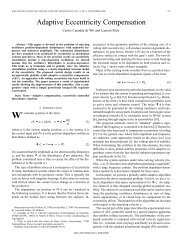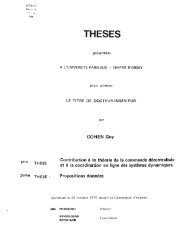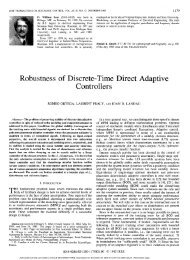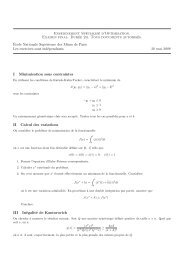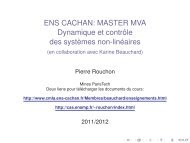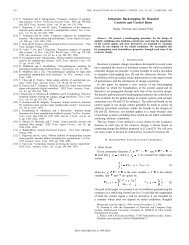HOMOGENEOUS OBSERVER DESIGN 1817R + <strong>is</strong> the degree, and φ ∞ : R n → R <strong>is</strong> the approximating function, if φ <strong>is</strong>continuous, φ ∞ <strong>is</strong> continuous and not identically zero, and, for each compactset C in R n \{0} and each ε> 0, there ex<strong>is</strong>ts λ ∞ such thatmaxφ(λ r∞ ⋄ x)x ∈ C∣ λ d∞− φ ∞ (x)∣ ≤ ε ∀ λ ≥ λ ∞ .• A vector field f = ∑ ni=1 f i ∂∂x i<strong>is</strong> said to be homogeneous in the ∞-limit withassociated triple (r ∞ , d ∞ ,f ∞ ), where r ∞ in (R + \{0}) n <strong>is</strong> the weight, d ∞ inR <strong>is</strong> the degree, and f ∞ = ∑ ni=1 f ∞,i ∂∂x i<strong>is</strong> the approximating vector field, if,for each i in {1,...,n}, d ∞ + r ∞,i ≥ 0 and the function f i <strong>is</strong> homogeneousin the ∞-limit with associated triple (r ∞ , d ∞ + r ∞,i ,f ∞,i ).Example 2.4. The function δ 2 : R → R given in the illustrative system (1.1) <strong>is</strong>homogeneous in the ∞-limit with associated triple (r ∞ ,d ∞ ,δ 2,∞ ) = (1, p, c ∞ x p 2 ).Furthermore, when p d 0r 0,i∀ i ∈ {1,...,n} .Example 2.9. We recall (1.6) and consider two homogeneous and positive definitefunctions φ 0 : R n → R + and φ ∞ : R n → R + with weights (r 0 ,r ∞ ) in (R + \{0}) 2n anddegrees (d 0 ,d ∞ ) in (R + \{0}) 2 . The function x ↦→ H(φ 0 (x),φ ∞ (x)) <strong>is</strong> positive definiteand homogeneous in the bi-limit with associated triples (r 0 ,d 0 ,φ 0 ) and (r ∞ ,d ∞ ,φ ∞ ).Th<strong>is</strong> way <strong>of</strong> constructing a homogeneous in the bi-limit function from two positivedefinite homogenous functions <strong>is</strong> extensively used in <strong>th<strong>is</strong></strong> paper.2.2. Properties <strong>of</strong> homogeneous approximations. To begin, we note thatthe weight and degree <strong>of</strong> a homogeneous in the 0- (resp., ∞-) limit function are1 Th<strong>is</strong> <strong>is</strong> proved <strong>by</strong> noting that, for all x in R n and all µ in R + \{0},φ 0 (µ r 0 ⋄ x)µ d 0= 1µ d lim φ (λ r 0 ⋄ (µ r 0 ⋄ x)) φ ((λµ) r 0 ⋄ x)0 λ→0 λ d = lim0λ→0 (λµ) d = φ 0 (x) ,0and similarly for the homogeneous in the ∞-limit function.<strong>Copyright</strong> © <strong>by</strong> <strong>SIAM</strong>. <strong>Unauthorized</strong> <strong>reproduction</strong> <strong>of</strong> <strong>th<strong>is</strong></strong> <strong>article</strong> <strong>is</strong> prohibited.
1818 V. ANDRIEU, L. PRALY, AND A. ASTOLFInot uniquely defined. Indeed, if φ <strong>is</strong> homogeneous in the 0- (resp., ∞-) limit withassociated triple (r 0 ,d 0 ,φ 0 ) (resp., (r ∞ ,d ∞ ,φ ∞ )), then it <strong>is</strong> also homogeneous in the0- (resp., ∞-) limit with associated triple (kr 0 , k d 0 ,φ 0 ) (resp., (kr ∞ , k d ∞ ,φ ∞ )) forall k>0. (Simply change λ into λ k .)It <strong>is</strong> straightforward to show that if φ and ζ are two functions homogeneous inthe 0- (resp., ∞-) limit, with weights r φ,0 and r ζ,0 (resp., r φ,∞ and r ζ,∞ ), degrees d φ,0and d ζ,0 (resp., d φ,∞ and d ζ,∞ ), and approximating functions φ 0 and ζ 0 (resp., φ ∞and ζ ∞ ), then the following hold:P1: If there ex<strong>is</strong>ts k in R + such that kr φ,0 = r ζ,0 (resp., kr φ,∞ = r ζ,∞ ), thenthe function x ↦→ φ(x) ζ(x) <strong>is</strong> homogeneous in the 0- (resp., ∞-) limit withweight r ζ,0 , degree kd φ,0 +d ζ,0 (resp., r ζ,∞ , kd φ,∞ +d ζ,∞ ) and approximatingfunction x ↦→ φ 0 (x) ζ 0 (x) (resp., x ↦→ φ ∞ (x) ζ ∞ (x)).dP2: If, for each j in {1,...,n},φ,0r φ,0,j< d ζ,0dr ζ,0,j(resp.,φ,∞r φ,∞,j> d ζ,∞r ζ,∞,j), thenthe function x ↦→ φ(x) +ζ(x) <strong>is</strong> homogeneous in the 0- (resp., ∞-) limitwith degree d φ,0 and weight r φ,0 (resp., d φ,∞ and r φ,∞ ) and approximatingfunction x ↦→ φ 0 (x) (resp., x ↦→ φ ∞ (x)). In <strong>th<strong>is</strong></strong> case we say that the functionφ dominates the function ζ in the 0-limit (resp., in the ∞-limit).P3: If the function φ 0 + ζ 0 (resp., φ ∞ + ζ ∞ ) <strong>is</strong> not identically zero and, for eachd φ,0r φ,0,j= d ζ,0r ζ,0,jdj in {1,...,n},(resp.,φ,∞r φ,∞,j= d ζ,∞r ζ,∞,j), then the functionx ↦→ φ(x) +ζ(x) <strong>is</strong> homogeneous in the 0- (resp., ∞-) limit with degreed φ,0 and weight r φ,0 (resp., d φ,∞ and r φ,∞ ) and approximating function x ↦→φ 0 (x) +ζ 0 (x) (resp., x ↦→ φ ∞ (x)+ζ ∞ (x)).Some properties <strong>of</strong> the composition or inverse <strong>of</strong> functions are given in the followingtwo propositions, the pro<strong>of</strong>s <strong>of</strong> which are given in Appendices A and B.Proposition 2.10 (composition function). If φ : R n → R and ζ : R → R arehomogeneous in the 0- (resp., ∞-) limit functions, with weights r φ,0 and r ζ,0 (resp.,r φ,∞ and r ζ,∞ ), degrees d φ,0 > 0 and d ζ,0 ≥ 0 (resp., d φ,∞ > 0 and d ζ,∞ ≥ 0),and approximating functions φ 0 and ζ 0 (resp., φ ∞ and ζ ∞ ), then ζ ◦ φ <strong>is</strong> homogeneousin the 0- (resp., ∞-) limit with weight r φ,0 (resp., r φ,∞ ), degree d ζ,0 d φ,0r ζ,0(resp.,d ζ,∞ d φ,∞r ζ,∞), and approximating function ζ 0 ◦ φ 0 (resp., ζ ∞ ◦ φ ∞ ).Proposition 2.11 (inverse function). Let φ : R → R be a bijective homogeneousin the 0- (resp., ∞-) limit function with associated triple ( )1,d 0 ,ϕ 0 x d0 with ϕ0 ≠0and d 0 > 0 (resp., ( )1,d ∞ ,ϕ ∞ x d∞ with ϕ∞ ≠0and d ∞ > 0). Then the inversefunction φ −1 : R → R <strong>is</strong> a homogeneous in the 0- (resp., ∞-) limit function withassociated triple (1, 1 d 0, ( x ϕ 0) 1d 01) (resp., (1,d ∞, ( xϕ ∞) 1d∞ )).Despite the ex<strong>is</strong>tence <strong>of</strong> well-known results concerning the derivative <strong>of</strong> a homogeneousfunction, it <strong>is</strong> not possible to say anything, in general, when dealing withhomogeneity in the limit. For example, the functionφ(x) =x 3 + x 2 sin(x 2 )+x 3 sin(1/x)+x 2 , x ∈ R ,<strong>is</strong> homogeneous in the bi-limit with associated triples(1, 2,x2 ) (, 1, 3,x3 ) .However, its derivative <strong>is</strong> homogeneous in neither the 0-limit nor the ∞-limit. Neverthelessthe following result holds, the pro<strong>of</strong> <strong>of</strong> which <strong>is</strong> elementary.Proposition 2.12 (integral function). If the function φ : R n → R <strong>is</strong> homogeneousin the 0- (resp., ∞-) limit with associated triple (r 0 ,d 0 ,φ 0 ) (resp., (r ∞ ,d ∞ ,φ ∞ )),<strong>Copyright</strong> © <strong>by</strong> <strong>SIAM</strong>. <strong>Unauthorized</strong> <strong>reproduction</strong> <strong>of</strong> <strong>th<strong>is</strong></strong> <strong>article</strong> <strong>is</strong> prohibited.
- Page 1 and 2: SIAM J. CONTROL OPTIM.Vol. 47, No.
- Page 3: 1816 V. ANDRIEU, L. PRALY, AND A. A
- Page 7 and 8: 1820 V. ANDRIEU, L. PRALY, AND A. A
- Page 9 and 10: 1822 V. ANDRIEU, L. PRALY, AND A. A
- Page 11 and 12: 1824 V. ANDRIEU, L. PRALY, AND A. A
- Page 13 and 14: 1826 V. ANDRIEU, L. PRALY, AND A. A
- Page 15 and 16: 1828 V. ANDRIEU, L. PRALY, AND A. A
- Page 17 and 18: 1830 V. ANDRIEU, L. PRALY, AND A. A
- Page 19 and 20: 1832 V. ANDRIEU, L. PRALY, AND A. A
- Page 21 and 22: 1834 V. ANDRIEU, L. PRALY, AND A. A
- Page 23 and 24: 1836 V. ANDRIEU, L. PRALY, AND A. A
- Page 25 and 26: 1838 V. ANDRIEU, L. PRALY, AND A. A
- Page 27 and 28: 1840 V. ANDRIEU, L. PRALY, AND A. A
- Page 29 and 30: 1842 V. ANDRIEU, L. PRALY, AND A. A
- Page 31 and 32: 1844 V. ANDRIEU, L. PRALY, AND A. A
- Page 33 and 34: 1846 V. ANDRIEU, L. PRALY, AND A. A
- Page 35 and 36: 1848 V. ANDRIEU, L. PRALY, AND A. A
- Page 37: 1850 V. ANDRIEU, L. PRALY, AND A. A




